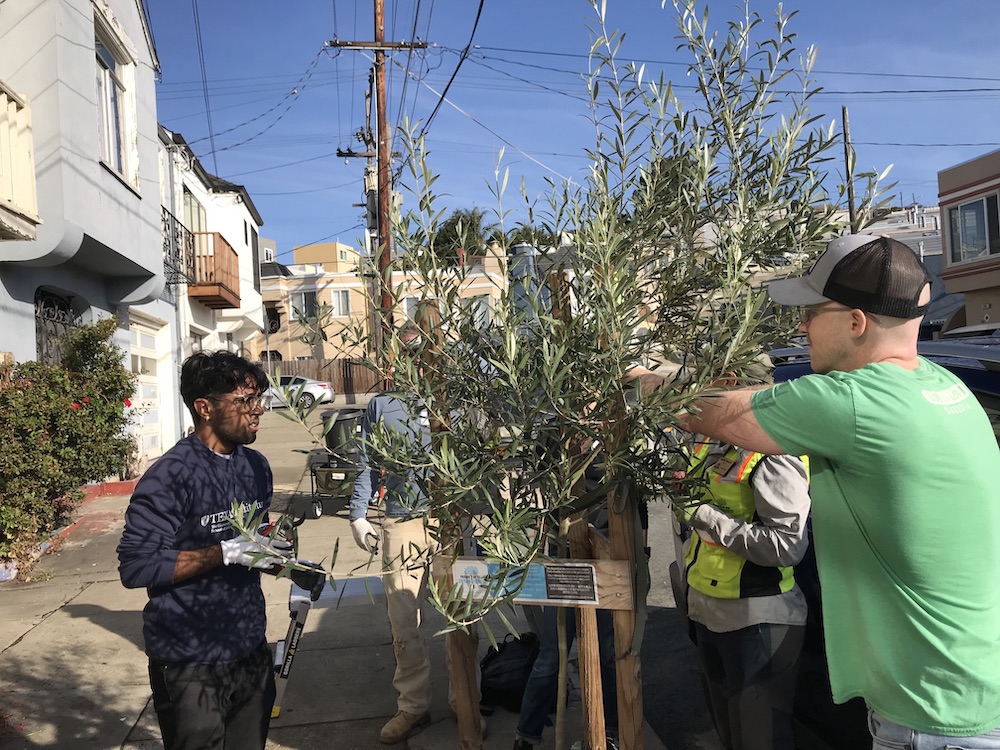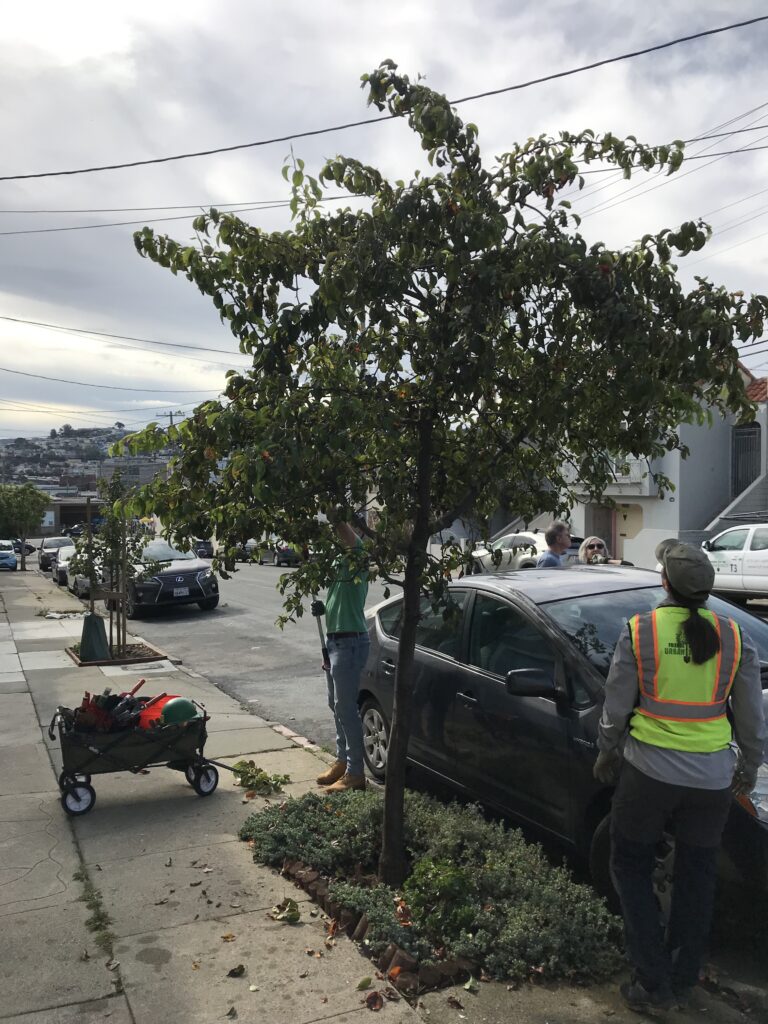For a few hours last Friday morning, an olive tree in Bayview Hunters Point received a level of attention rivaling Biden at APEC. Three canvas roller carts full of gardening tools and more than a dozen volunteers surrounded the two-year old Olea europaea as Annika Peterson, certified arborist for Friends of the Urban Forest, laid out the plan for the day.
“Today’s like your doctor’s checkup, a kind of preventative care,” Petersen said.
FUF has been planting and maintaining trees in San Francisco since 1981. The nonprofit’s love for trees is rooted not just in the hands-on pruning skills that will be taught over the next few hours, but the bigger issues of health, equity and environment that trees can help address. San Francisco, the third-fastest-warming city in California, lags behind other major cities in terms of street canopy, so the work ahead is clear.

“Planting trees is a really effective way of showing support without stomping all over how someone cares about or views their neighborhood,” Dr. Bunny McFadden, Community Workforce Development Director for FUF, said by phone.
And no San Francisco neighborhood has felt more stomped on than Bayview Hunters Point. Not only did a history of redlining force many low-income BIPOC communities into the substandard housing of this industrialized area, the lack of trees—and vast expanses of concrete—makes this neighborhood in San Francisco the hottest and unhealthiest place to be.
Today’s small group of volunteers can’t roll back that past. But Dan Odette, a volunteer from Oakland, is ready to roll back his sleeves and do what he can.
“These volunteer opportunities get me to parts of the city I’ve never been to before,” Odette said. “And I love returning to these areas to check on the progress of the trees.”
After some safety instruction (“Be spatially aware when swinging hammers”), the 15 or so volunteers break into three groups, led by a FUF leader with a three-step process for each tree: diagnose overall health; check structural integrity; and review the supportive hardware.
Help us save local journalism!
Every tax-deductible donation helps us grow to cover the issues that mean the most to our community. Become a 48 Hills Hero and support the only daily progressive news source in the Bay Area.
To set the tone, Petersen, a born teacher, asks everyone for their favorite tree story. Bill Maggs from the Mission District talks about a 100-year-old avocado tree with Giving Tree-level reverence. Prana Subramanian recalls hanging “nearly horizontal” as a child from an oak tree in Texas during a storm, and how he thanks that tree when he visits home. And Odette describes a love/hate relationship with his indoor fiddly fig tree that sounds as earnest as most human relationships.
Tree spirits manifested, it’s time to inspect the roots, the foundation of tree health. Petersen instructs Maggs to gently explore around the base of the tree with a root knife.
“We want to make sure that the roots are going down and out, not in circles,” Petersen said.

The examination moves up, insuring the trunk is not sitting in wet soil, and then volunteers spot-check for scales or any signs of struggle in the leaves, until necks are slightly craned, trying to spot the “leader.”
“We want our trainees to have a clear leader stem going up, so they’ve got a good distribution of branches around.”
Big lessons branch out from the smallest details. When Petersen notices the water bag is too full (new trees nurse off a bag for their first year), she instructs Odette to puncture the bag with a nail to compensate for the blockage. Water talk, that classic California conversation, bubbles up, from where we get it, how we use it, and, mostly how badly we manage it.
Mike Neumann, COO of Wu Yee Childcare who has used FUF to plant dozens of trees at their facilities, praised trees as an educational tool for kids of all ages.
“Bringing nature to the children in our centers is an important thing,” Newman said by phone. “It’s putting kids in touch with nature, when they’re typically surrounded by a lot of concrete.”
The final step of the tree inspection, checking the hardware, proves the trickiest. The impulse is to tighten straps around the leader to force the branch into straight, stiff attention. Petersen gently teaches against that.
“We adjust these straps to give the tree some wiggle room, because that will help it develop.” By allowing the tree this wiggle, the roots are stimulated to strengthen when the tree bows in the wind. “As we like to say, we want to ‘stir the pot’ with a few inches of motion in each direction.”
After crossing Apollo to work on a pear tree, the group is greeted by Nick Gallegos, who steps out of his garage to offer drinks. “We were one of the first ones to get a tree,” Gallegos, who grew up on Potrero Hill, said while explaining the FUF adoption program. “It immediately made our house 1,000 times better.”
Gallegos is well aware of the host of issues that plague the Bayview, such as food deserts, which is somewhat alleviated by the Food Co down the hill, although Gallegos noted the gauntlet of processed foods before all the fruits and vegetables. But he’s bullish on trees.
“I think it (planting trees) does create a better community,” Gallegos said. Then pointing to the olive tree the volunteers just left, he adds, “I’ve never talked to those neighbors before I got this tree.”

As the day progresses, the pruners snip quicker, the hammers strike with more confidence, and the conversations flow with the eager work. And that work does not go unnoticed.
Larry Patterson, trudging up the hill from the Food Co with his groceries, pauses to thank the volunteers for their work.
“We need trees. Trees purify the city,” Patterson, who has lived in an apartment on Apollo for three years, said. “All we’re doing is walking on concrete every day. You guys are doing a beautiful job.”
When asked how the lack of trees could cause real problems in a city known for comfortable weather year-round, Patterson has already felt the effects firsthand.
“I live on the corner there,” Patterson said. “I got a big, bay window. And that’s where the sun comes in when it rises. The neighbors tore down the trees, and that sun comes right in and heats up my home.”
More distressing than the unwanted heat, though, is the loss of the humming bird that used to visit Patterson’s backyard. “I can’t speak for everybody else, but, as far as me, I’m a nature guy.”
To wrap-up the day, team leaders offer “shout-outs” for stellar work, including a “shout-out to Jessica for not tying down a stake that was rubbing a branch,” and a “shout-out to our group for tying ties, like, the fastest I’ve seen a group do ties in a long time.” Odette gets his gold star for “just always looking for ways to help and keep busy.”
Odette stands back, more happy than weary, and takes the work in. “This whole block would basically be treeless if it wasn’t for FUF planting all these trees.”
After some handshakes and a few phone exchanges, the volunteers disperse. We leave the Bayview, but a final sentiment from Patterson, a Bayview resident, lingers.
“You can’t build trees like houses, man. You know what I mean? When you cut them down and cut them up? They’re gone forever, like humans.”




